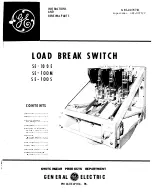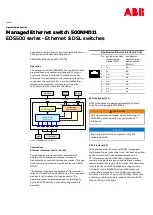
GEI-88767
LUBRICATION
In order to maintain reliable operation, it is important that all parts
of the mechanism be properly lubricated at all times. All bearings and
other parts of the mechanism subjected to wear have been properly lu
bricated, during assembly at the factory, using the finest grades of
lubricants available. However, even the finest oils and greases have a
tendency to oxidize with age, as evidenced by hardening and darkening
in color. Elimination of the hardened lubricant is essential for the
proper operation of the switch. Also frequent operation of the device
causes the lubricant to be forced out from between the bearing surfaces.
A simple lubrication will often clear up minor disturbances which might
be mistaken for more serious trouble.
A definite lubrication schedule should be set up taking into considera
tion the frequency of operation of the switch and local conditions.
Until such a schedule is worked out, the switch should be lubricated
at each periodic inspection and also whenever it is overhauled, in ac
cordance with the lubrication chart, Fig. {11) . It is also recommended
that the device be operated at regular intervals to insure the user that
the equipment is operating freely.
The lubrication chart, Fig. (11) is divided into two methods of lubrica
tion. The first method outlines the maintenance lubrication which should
be performed at the time of periodic maintenance, and requires no dis
assembly. The second method outlines a lubrication procedure similar
to that performed on the device at the factory, but should be used only
in case of a general overhaul or disassembly for other reasons.
General Electric Lubricants D50Hl5 and D50H47 are available in 1/4# col
lapsible tubes. It is so packaged to insure cleanliness and to prevent
oxidation.
Method of
Whenever cleaning is required, the bearings should be placed in a con-
tainer of clean petroleum solvent or similar cleaner.
DO
NOT USE C
ARBO
N
TETRACHLORIDE. If the grease in the bearings has become badly oxidized,
it may be necessary to use alcohol (type used for thinning shellac) to
remove it. Ordinarily, by agitating the bearings in the cleaning solution,
and using a stiff brush to remove the solid particles, the bearings can
be satisfactorily cleaned.
Do
not handle the bearings with bare hands
as deposits from the skin onto the bearings are inductive to co�rosion.
If the bearings are touched, the contamination can be removed by washing
in alcohol. After the bearings have been thoroughly cleaned, spin them
in clean new light machine oil until the cleaner or solvent is entirely
removed. Allow this oil to drain off and then repack them immediately
with G-E lubricant D50Hl5 being sure all metal parts are greased.
NOTE: If it becomes necessary to clean the bearings in alcohol (shellac
thinner) , be sure the alcohol is perfectly clean, and do not allow the
.�
bearings to remain in the alcohol more than a few hours. If it is desir-
10









































